With Glasgow City being the most successful club in the Scottish women’s game and a regular entrant in the Champions League (with a quarter-final in 2014/15 and 2019/20 their best results), a lot is expected of them each season. Between 2007 and 2021, they set a record that will be difficult to beat, when they secured 14 consecutive league titles in a period when Chelsea Women star Erin Cuthbert and Reading Women defender Emma Mukandi were among plenty of star names to pull on the famous orange shirt.
However, last season, that run came to an abrupt end, with Rangers Women causing an upset and winning the league for the first time in their history, and that led to many fans wondering if Glasgow’s era of dominance was over and if there would now be closer competition between them, Rangers and Celtic Women, as the top three sides in the Scottish Women’s Premier League 1 (SWPL 1).
Whilst that certainly looked likely at the beginning of the season, when all three sides were securing maximum points week after week, both Rangers and Celtic have since fallen away and allowed Glasgow to build a five-point lead at the summit, with just seven rounds of the regular season remaining.
On the field, what has been so impressive about Glasgow is the fact that they have focused solely on themselves and ensured that they continue to improve as each game goes by, and evidence of their development under now-former head coach Eileen Gleeson (who left in December after needing to return to her native Dublin) comes in the fact that their performances have become more convincing as the campaign has progressed.
This tactical analysis will look in closer detail at their development during the campaign, with particular emphasis on how they have increased their offensive threat, how the midfielders have played a central role in their tactics and how their defensive setup has made them a tougher side to break down. In doing so, the analysis will highlight the reasons why they have been the team to beat this year, and why they are firmly on course for yet another SWPL 1 title.
Offensive threat
Last season, Glasgow City found the net 89 times in their 27 league games, which saw them finish as the second-highest scorers in the league (behind Rangers). This time around, they already have 61 goals, having played 15 matches, and, whilst that is less than both of their city rivals, they are clearly doing something to ensure that they are as productive as possible when they have opportunities to score.
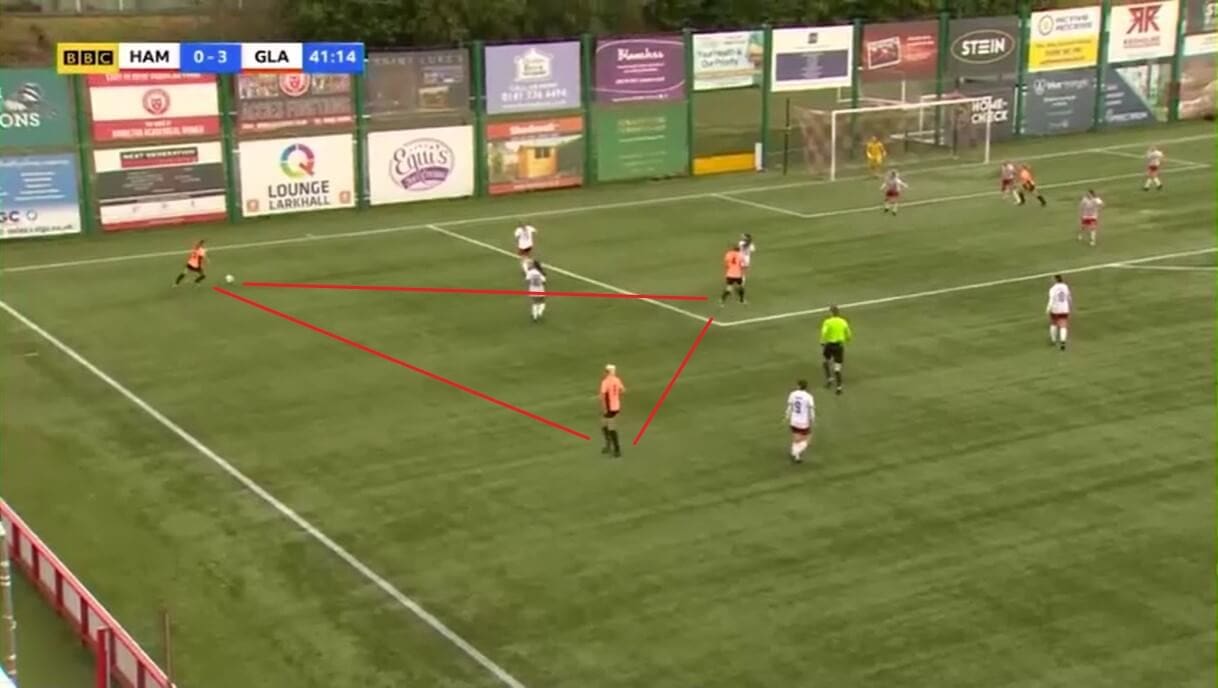
In general, it all comes down to their numerical overloads, with Glasgow constantly looking to push as many players into forward areas as possible whenever they have the ball, and that always gives teams an advantage when they are looking to create goalscoring opportunities.
However, that on its own is not enough to break opposing defences down, as the back line could just stay compact and put as many bodies between the ball and the goal as possible. Therefore, Glasgow use the wings in order to prevent that from happening, with their build-up play in wide areas helping to spread the opposing side out and provide the central players with avenues that they can then exploit.
In order to dominate those areas though, Glasgow know that they need to flood them with numbers in order to prevent their opponents from marking player-to-player, and that is where having attacking full-backs is really important. In this case, Amy Muir has moved up the field to offer support to her teammates, and the fact that she has joined Hayley Lauder and Costa Rica forward Priscila Chinchilla in this area means that, even if Hamilton Women look to close the ball down here, there will be a way for Glasgow to keep their attack alive.
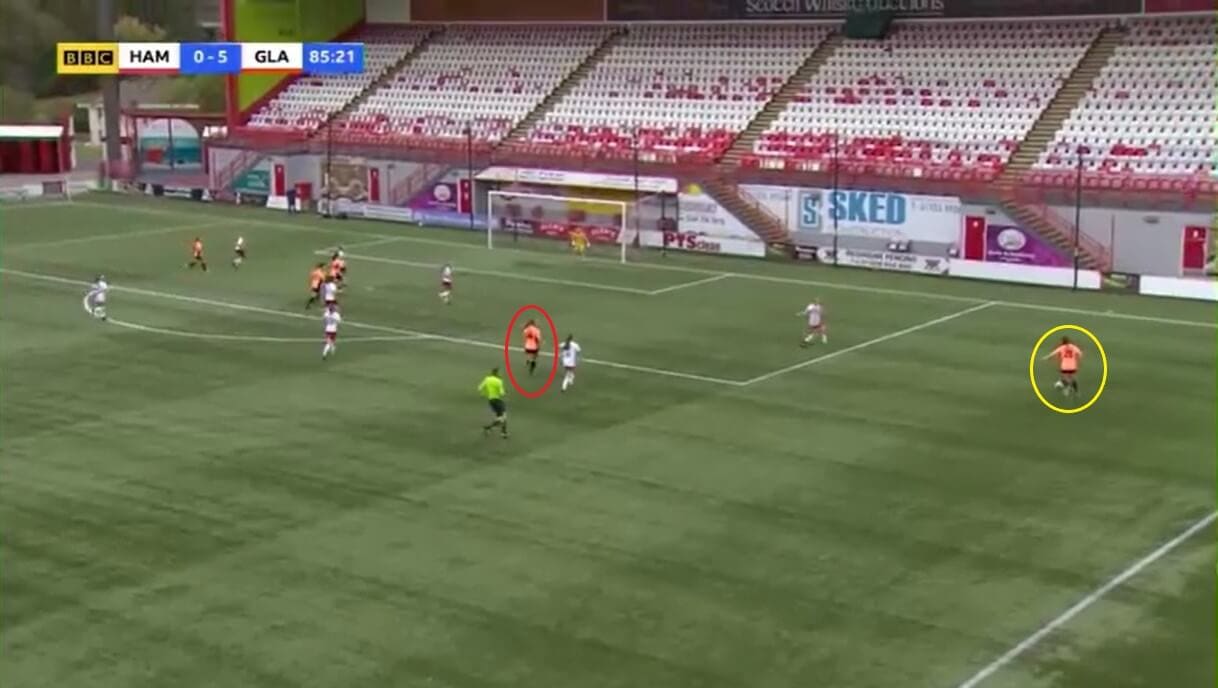
The fact that they have full-backs who are comfortable playing in advanced areas is a big positive for Glasgow, as it enables their wingers to play much further inside the field and offer extra goalscoring threats. In this case, American right-back Erin Greening has possession inside the final third, and the fact that she has control of the wing means that Scotland forward Lauren Davidson, who would ordinarily be further towards the sideline here, has been able to take up a much more central position and offer another goalscoring threat.
It is not uncommon to see the likes of Davidson and Chinchilla cutting inside whenever Glasgow have the ball, as it was a key part of their tactics last season, but the tactical tweak has come in the fact that they are no longer depended on to deliver balls into the middle as much as they were, so they have been able to work in closer proximity with the central striker and get on the scoreboard more often. Davidson in particular has really excelled in this slightly different way of playing, with the 21-year-old finding the net on 11 occasions to date and contributing five assists, so it is definitely one reason for Glasgow’s improvement this season.
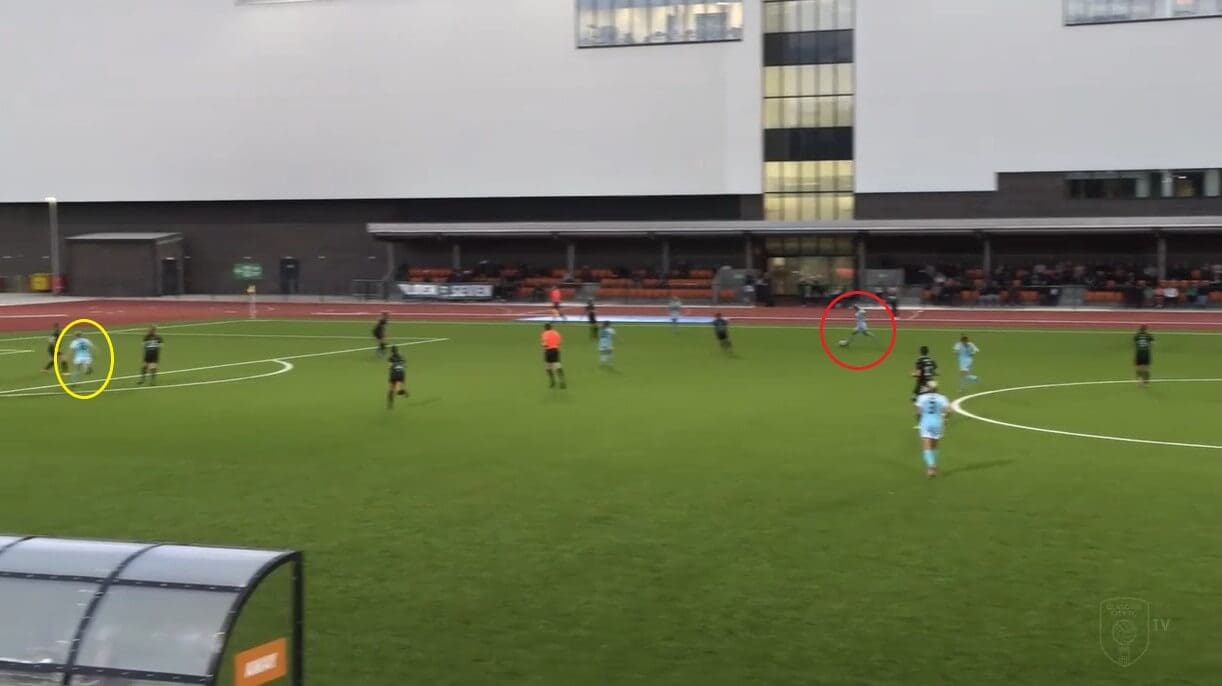
It is important to note that they don’t only have one way of attacking though, and can adapt to different situations. In this case, with Hibernian Women keeping players back, they needed to have a more direct approach and send balls into the central areas earlier, as that is where Hibernian have shown fragility and have not been able to compete.
Therefore, the tactics switched so that the full-backs didn’t get into the final third as often and instead played long balls from deeper areas. In this case, Megan Foley is looking to find striker Emily Whelan, who is in the yellow circle, and the fact that this ends up being a goal for the summer signing from Birmingham City Women shows how, even when Glasgow are forced to play in an alternative way, they still pose a threat.
Midfield roles
As well as their goalscoring quality, Glasgow City’s ability to keep the ball moving around the pitch at a good tempo has also played a part in their good form, and that again comes down to good recruitment and having players who are comfortable playing fast football and who have a good awareness of their surroundings.
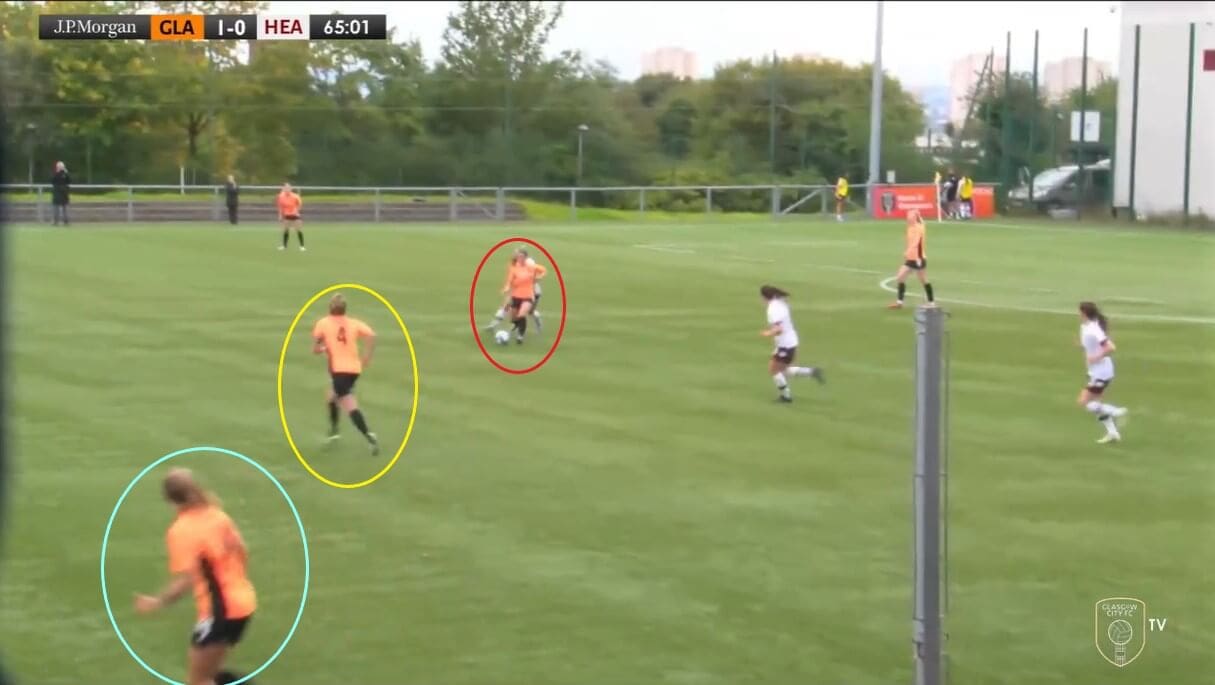
With many attacks starting from their back line, it is important that players are always alert and are constantly offering passing options for each other, as what Glasgow don’t want is to have one player keep hold of the ball for a fraction of a second longer than necessary and risk being closed down.
However, this is one thing that they have generally been good at, with their 80.9% passing accuracy indicating how they don’t often lose possession in a cheap manner, and one reason for that is their ability to plan ahead and ensure that they always keep the ball progressing up the field.
To explain, Mairead Fulton has possession here and is turning to find a teammate, with Lauder, in the yellow circle, a clear passing option. However, outside Lauder, Davidson, in the blue circle, is already making a run up the field, knowing that the former will need a passing option as soon as she receives the ball, and that shows how she is looking ahead and always assessing where she can have an effect on the game.
She is not the only player who has demonstrated this intelligence as the season has gone on, and it is not the most noticeable thing during games. However, it is an important part of Glasgow’s transitional play and is a major reason for them being able to play through the thirds without often giving the ball away.

Once they do lose possession, Glasgow’s focus instantly switches towards closing their opponents down and making the pitch as small as possible. In this case, Celtic’s New Zealand midfielder Olivia Chance, who has been a key source of their creativity since joining from Brisbane Roar Women in 2021, has received the ball and is now looking to set up a goalscoring opportunity for her side.
However, Fulton has recognised the danger that the former Bristol City Women player poses here and has instantly looked to close her down, teaming up with Whelan to ensure that all possible angles are covered. This is why Glasgow are still unbeaten after 15 games, because they aren’t flawless, but are simply able to react whenever they do make a mistake and try to regain possession as quickly as possible.
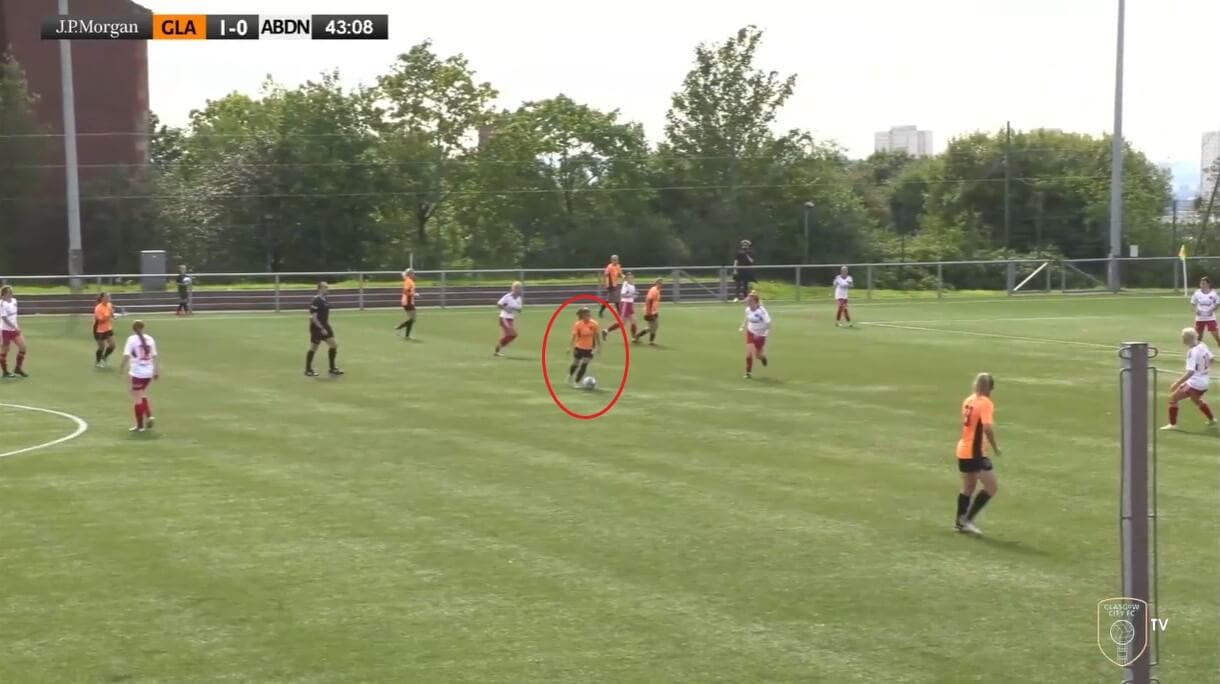
A major theme in Glasgow’s squad is versatility, with every player that they sign or bring up from their academy needing to be capable of filling two or three different roles in order to be a regular in the side.
Lauder is one player who has fitted that mould for a long time, with her often playing at left-back but also being strong in a midfield role, and another versatile player is Poland international Kinga Kozak, who was signed from Czarni Sosnowiec in her home country last summer.
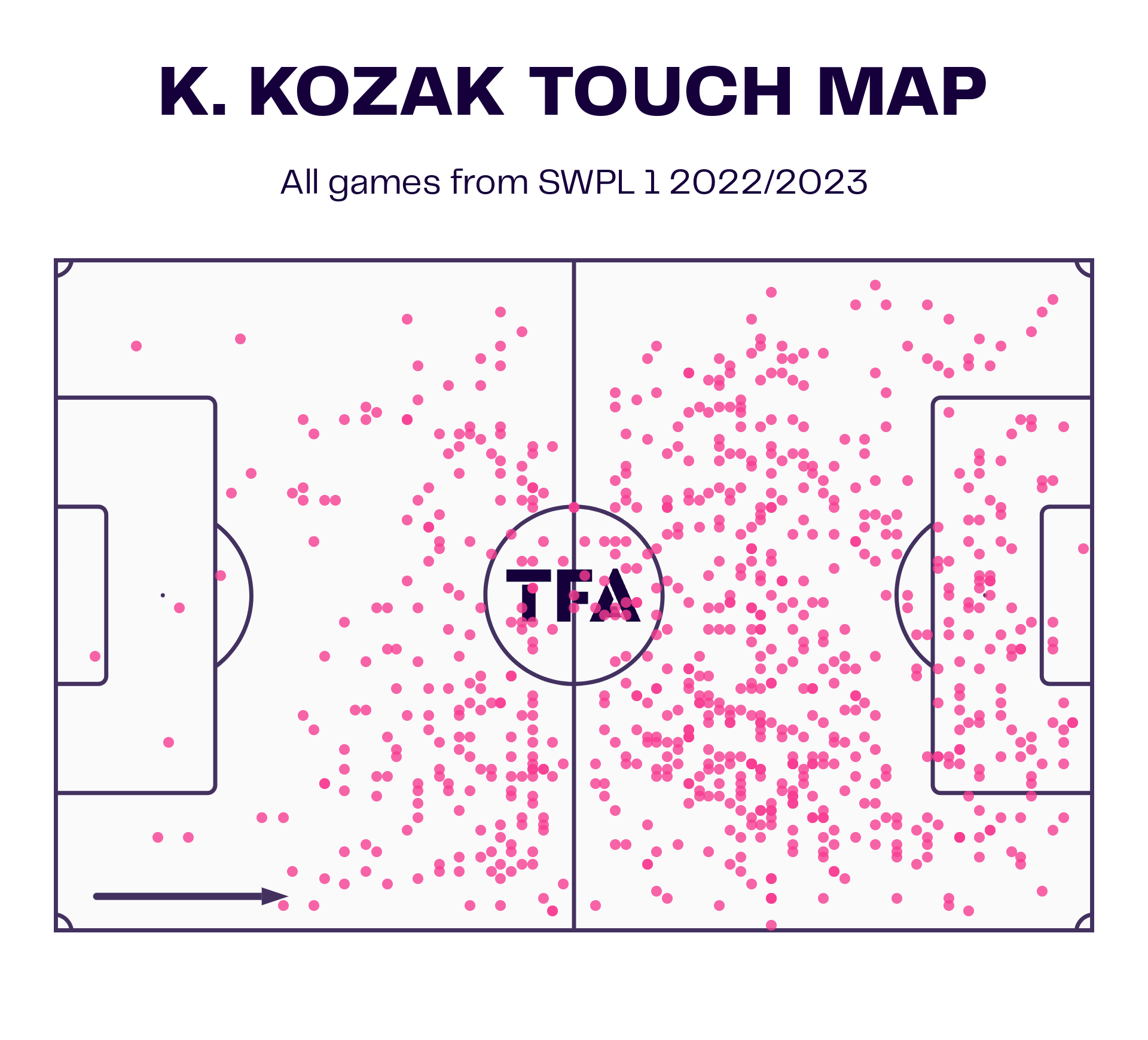
As this touch map indicates, Kozak is capable of playing in almost any area of the field, and it is common to see her protecting the defence one minute and standing on the edge of the goal area the next, with her often switching between roles as the ball moves through different phases of play.
Her importance to the team is demonstrated by the fact that she has recorded an individual passing accuracy of 77.3% and has made 37 interceptions in total, so she can break up play and move the ball into teammates, whilst she has also weighed in with five goals to her name so far and so offers a significant goalscoring threat when one is needed.
There is no doubt that, if Glasgow want to continue their run towards what is increasingly looking like a 16th league title, they will need her to be in top form during every game because she is the type of player who can make a difference when scorelines are tight and so could help to decide where the trophy ends up.
Defensive play
However, a title win is not only built on strong attacking play and how teams perform in the central third because having a solid defence is just as important. Fortunately for Glasgow City, they have on the whole been a robust team in their own third, with only six goals being conceded so far, so there is no doubt that their defenders have been just as instrumental in their good form as those higher up the field have.
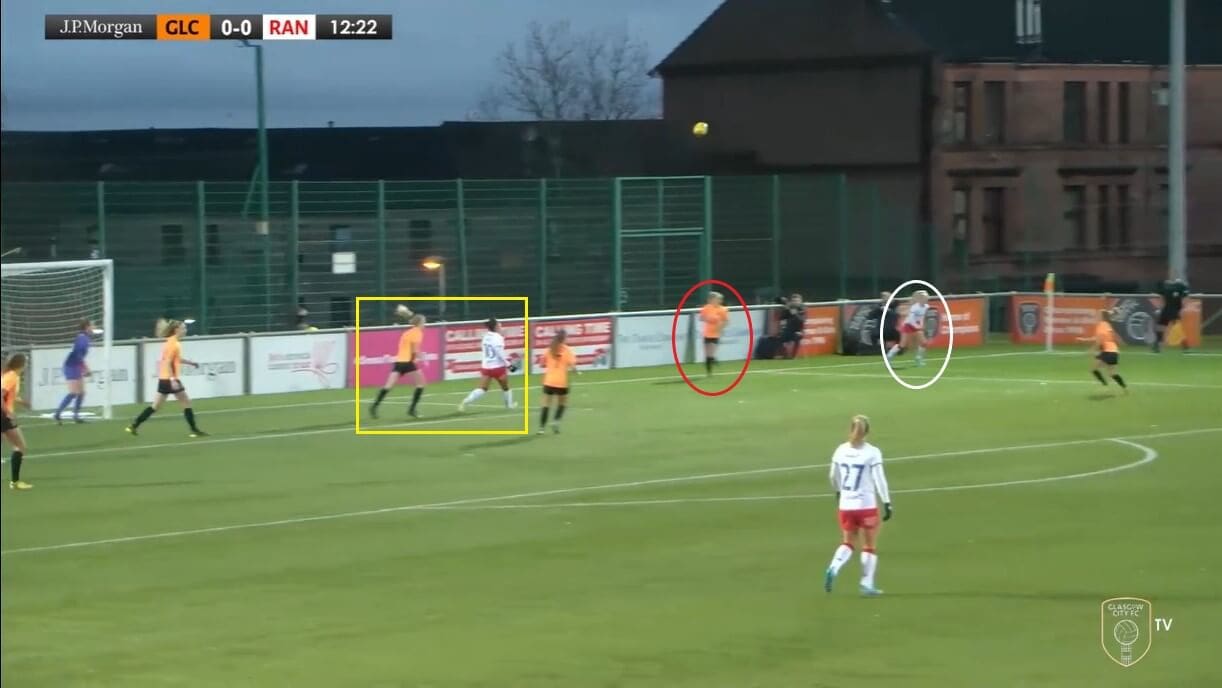
As with their transitional play in the midfield, a lot of the good work that Glasgow do inside their own third comes from their players being aware of their surroundings and recognising where they can have an effect on the game. With that awareness in place, they can generally set up their shape early and make themselves hard to break down.
Each player has a role to play in this setup though, with the full-backs tasked with getting out to the ball and slowing the opposing team’s progress down, whilst the two centre-backs focus on identifying the possible targets inside the pitch and working hard to limit their effectiveness. In this case, when Rangers’ Scotland winger Brogan Hay was able to find a way past Muir, she was looking for Jamaica striker Kayla McCoy, but this had been spotted by Republic of Ireland defender Claire Walsh and McCoy was therefore unable to control the ball, turn and shoot at goal, with her instead under instant pressure from Glasgow.
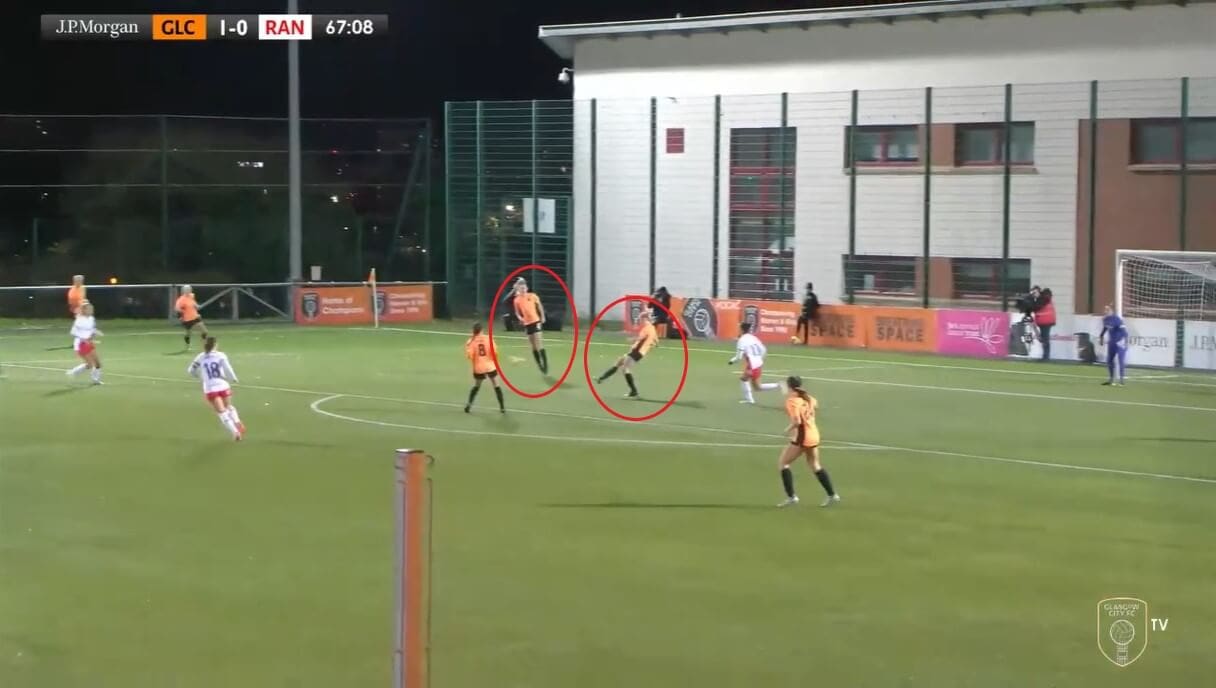
Glasgow’s central defensive pairing is normally made up of Walsh and Jenna Clark, and this is because both are tall players who are dominant both on the ground and, perhaps more importantly, in the air, and this is highlighted by the fact that Glasgow as a team have won 55.7% of their aerial duels and 68.7% of their defensive duels so far.
In this case though, what they had over Rangers was an ability to read the game, with them able to see the spaces and react to threats in good time. As a result, when Finland international Jenny Danielsson sent a cross into the goal area, Walsh was able to meet the delivery and clear her lines. Therefore, when analysing why Glasgow have been so hard to break down in their own third this season, having these two in their back line has definitely been a factor.
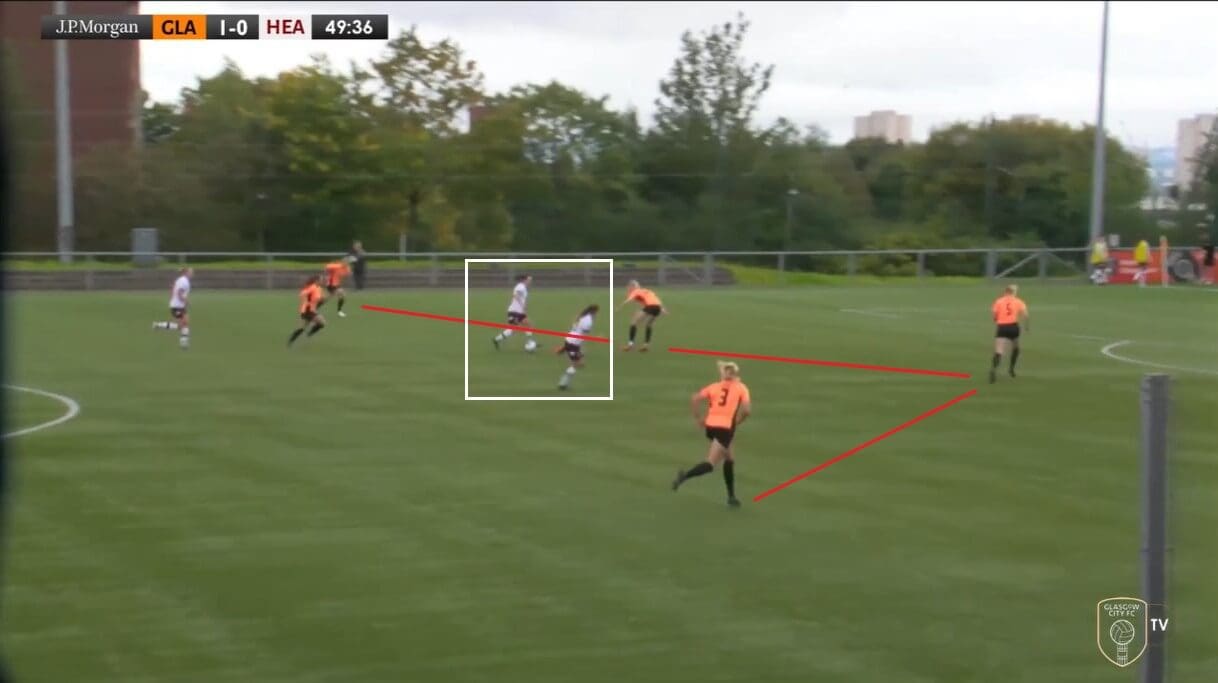
However, the fact that they have conceded an average of 0.43 goals per game does indicate that there are ways to beat them, and one situation in which they have looked fragile is when opponents are able to counterattack against them at speed. Here, they have been caught out whilst trying to play out from the back and have given the ball straight to Hearts midfielder Ciara Grant. Now, with them not having time to set up the shape that was highlighted previously, there are significant gaps in their back line and Hearts are able to get a shot away at goal, with New Zealand forward Katie Rood doing just that but seeing her effort saved.
Hearts, who have been managed by Spanish coach Eva Olid since 2021 and who have shown a lot of development this season, are not the only side who have benefitted from moments like this. Therefore, it is an area that Glasgow can still improve on, and they will need to eradicate these errors if they are to hold off their title rivals and regain their SWPL 1 crown.
Conclusion
In conclusion, this tactical analysis has looked in detail at Glasgow City’s progress during the 2022/23 SWPL 1 campaign, with the Scottish giants currently sitting at the top of the league and looking firmly on course to regain their crown from Rangers.
As the scout report has indicated, there is a lot to like about Glasgow at the moment, with them playing an attractive style of football that has made them hard to play against. There are still small details that need to be improved, but, with “a culture of high standards” at the club (as Eileen Gleeson stated when appointed), they will know that only hard work will help them to achieve their aims, and will be only too aware that titles are not won until they are mathematically secured.
It is also worth keeping in mind that they are still under the interim management of former captain Leanne Ross, who has said that she doesn’t want the permanent job at this point in her career, so there will be a new manager appointed at some point who may bring new ideas. They also still have to travel to both Rangers and Celtic before the regular season ends (with Rangers their opponents this weekend), and both of those games will be vital in deciding the ultimate destination of the SWPL 1 trophy. Therefore, there are still plenty of things that could go against them in the next months, so, whilst they are on track to win the league and regain their title, they are most definitely not there yet.





Comments